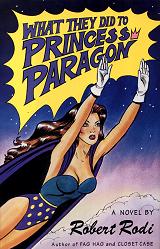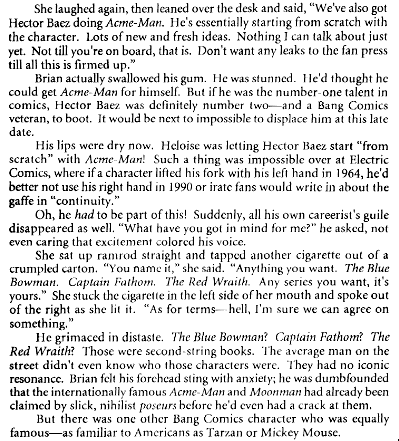What They Did to Princess Paragon
 Don’t let the lack of pictures fool you; this is a comic book.
Don’t let the lack of pictures fool you; this is a comic book.
- It’s clearly a “book”, and it’s highly “comic”. Rodi has a real knack for clever turns of phrase, for painfully spot-on characterisation, and farcical plot twists that would do Oscar Wilde proud.
- It’s about superheroes, the artists who produce them, the fans who adore them both, the companies that publish them, and even the people who actually create them. It’s a commentary on the comics industry.
- It manages to convey some important moral lessons even while pandering to the base entertainment desires of the reader. In other words: it’s fun, but makes you think.
- There’s a flying, scantily-clad woman with large breasts on the cover.
What They Did To Princess Paragon is set on an alternate world, one very much like our own, but with subtle differences. Basically, the names and details have been changed to protect the innocent (and guilty)… Earth-P, if you will. It is the story of Princess Paragon, one of the (poorly selling) founding characters of Bang Comics. With nowhere else to go but cancellation, and following in the footsteps of the grim-n-gritty revamp of Moonman and the reboot of Acme-Man, hot-shot writer/artist Brian Parrish decides to come on board at Bang… and make the princess a lesbian. But twenty-something still-at-home Paragon fanboy Jerome T. Kornacker isn’t about to take this new direction lying down….
 It’s clear from the outset of the book that it’s written to be fun for fanboys (especially fanboys who fancy themselves as more sophisticated than the garden-variety fanboys who are made fun of {grin}). See how many characters and creators you can identify from the descriptions of their doppelgangers… Bang Comics is DC, Electric is Marvel, Acme-Man is Superman, meaning that Hector Baez is John Byrne, or is he George Pérez…? (Just remember that these are fictional characters; not everyone has a real-world equivalent, and don’t assume that the correspondences are exact.) I have to feel a little sorry for anyone from outside of fandom, who will read these elements and not “get” them all. But that’s really just my desperate attempt to convince myself that my knowledge of the comics industry somehow elevates me above the masses… the book is a good read even without it.
It’s clear from the outset of the book that it’s written to be fun for fanboys (especially fanboys who fancy themselves as more sophisticated than the garden-variety fanboys who are made fun of {grin}). See how many characters and creators you can identify from the descriptions of their doppelgangers… Bang Comics is DC, Electric is Marvel, Acme-Man is Superman, meaning that Hector Baez is John Byrne, or is he George Pérez…? (Just remember that these are fictional characters; not everyone has a real-world equivalent, and don’t assume that the correspondences are exact.) I have to feel a little sorry for anyone from outside of fandom, who will read these elements and not “get” them all. But that’s really just my desperate attempt to convince myself that my knowledge of the comics industry somehow elevates me above the masses… the book is a good read even without it.
(One thing that briefly “knocked me out of the story” was a passing mention of “Wonder Woman”. It was kind of like Alan Scott showing up without explanation in a story set on Earth-1. Geez, I’m a continuity freak after all, aren’t I?)
Some of the best characters are the ones that borrow the least from actual Earth-prime individuals. Parrish (as far as I know) bears little resemblance to George Pérez (the man who really did revamp Wonder Woman, with a strongly feminist - but not lesbian - angle), and is neither all hero nor a villain. The improbably-named Perpetrial Cotton bears an alarming resemblance to a few wimmin I know, but I couldn’t help liking her. And Jerome, who begins as a demeaning fanboy stereotype, ends up as… well, something a little different from that.
I couldn’t help thinking, as I read, about the difference between what I was reading and what I was reading about. For instance, this book really wouldn’t have been the same if it had been done in graphic format. Much of the humour comes from Rodi’s insightful (sometimes biting) verbal descriptions. Getting the same humour in comics format could only be done with broad visual parody or redundant captioning, which just wouldn’t come across the same. Maybe this is why I found so much more humour in Princess Paragon than in most “funny books”. The way in which Parrish’s gum chewing reflects his mood would be damn hard to depict in comics, but Rodi deftly describes the hidden treatment Parrish gives his Dentyne. If the canvas of the imagination counts, the “art” in this book was great.
The story takes some unexpected turns, ones that a familiarity with the real-world comics industry does nothing to help foresee. Jerome’s first encounter with Brian Parrish is predictable; what happens next is not. Even when you think you know how it’s going to end, there are still some surprises in store. And as the dust-jacket blurb concludes, “only when it’s too late does Brian understand what he’s really done to Princess Paragon.”
This book probably isn’t available at your local comics shop; you may have to look in a “legitimate” bookstore or library to find it. Don’t be intimidated; they just store their back issues a little differently. And they tend to alphabetize by author, not publisher and title (so look under R for “Rodi, Robert”). But other than that, the geeks who hang out there are not that different from you or me. {grin}
